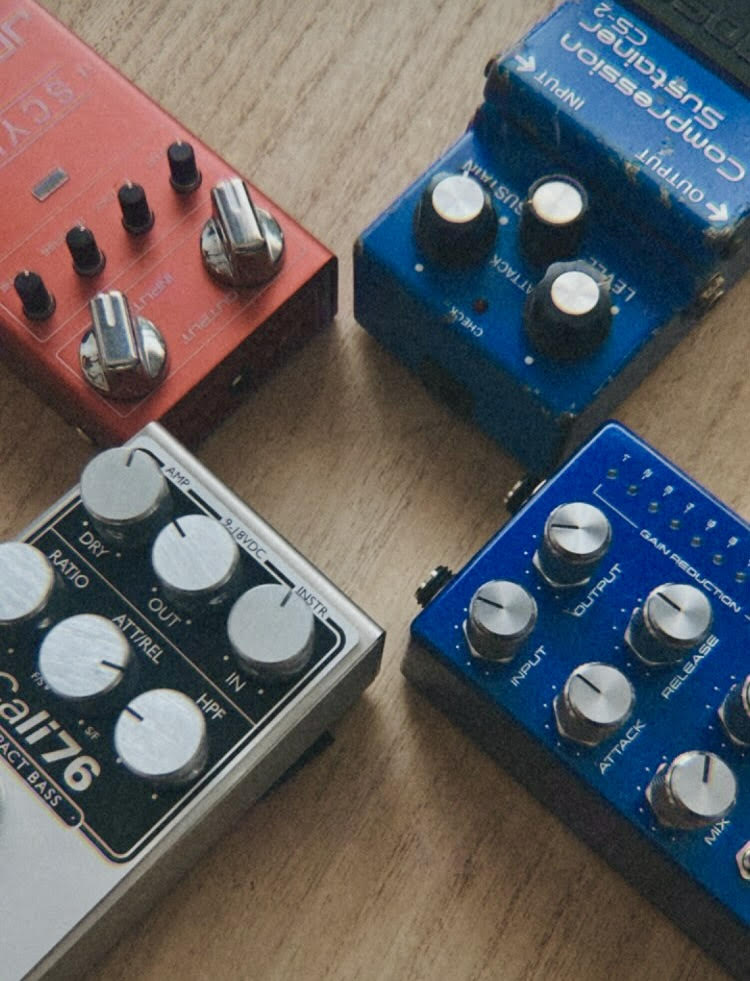
Compression for Bass Players
Understanding Compression: A Deep Dive Understanding Compression for Bass Players: A Deep Dive Compression is one of the most essential tools in a bass player’s arsenal, whether in the studio or on stage. While it often operates subtly, compression can significantly enhance a bassist’s tone, adding consistency, sustain, and punch. This article will explore the history of compression in studio settings, break down its key components, and highlight some of the best compressor pedals used by bassists over the years. A Brief History of Compression in Studio Recording Compression has been a staple in recording studios since the early days of analog technology. Originally, compressors were designed to control the dynamic range of signals, ensuring that audio did not distort or become inaudible. Early tube-based compressors like the Fairchild 670 and the Universal Audio 1176 became legendary in the 1960s, used to shape the sound of countless classic records. For bass recordings, engineers quickly discovered that compression helped maintain an even level, preventing peaks from overpowering the mix and ensuring the lower frequencies remained solid and controlled. By the 1970s and 1980s, compression was a standard part of bass recording techniques, used on records ranging from Motown grooves to rock anthems. As technology progressed, digital compressors and software plugins allowed for even greater precision and flexibility in bass tone shaping. Key Components of Compression To understand how compression affects bass guitar tone, it’s important to break down its main components: 1. Threshold The threshold determines the volume level at which compression begins. If a signal exceeds the set threshold, the compressor engages and reduces the level. For bass players, setting the threshold correctly ensures that only the loudest notes are affected, keeping dynamics intact while smoothing peaks. 2. Ratio The ratio controls how much the signal is reduced once it surpasses the threshold. A 2:1 ratio means that for every 2dB the signal exceeds the threshold, only 1dB will pass through. Higher ratios (such as 10:1 or higher) create a limiting effect, where peaks are heavily compressed. 3. Attack and Release 4. Makeup Gain Since compression reduces peak volume, makeup gain allows the overall level to be restored, ensuring the signal remains audible in the mix without unwanted volume dips. Classic Compressor Pedals for Bass Players While studio compressors have played a key role in recorded bass tones, live players have long relied on compressor pedals to achieve a controlled and polished sound. Here are some of the most well-known compressor pedals that bassists have used over the years: 1. MXR M87 Bass Compressor A favorite among modern bassists, the MXR M87 provides studio-grade compression in a pedal format, with a full range of controls including attack, release, and ratio. Its transparent sound makes it suitable for various genres. 2. Boss CS-2 and CS-3 Compression Sustainer The Boss CS-2 (discontinued) and its successor, the CS-3, have been widely used by bassists who want a simple but effective compressor. While they are more commonly associated with guitarists, they offer a smooth sustain that benefits bass players as well. 3. EBS MultiComp Designed specifically for bass, the EBS MultiComp is a highly regarded pedal with multiple compression modes, including solid-state, tube emulation, and multi-band compression, allowing players to dial in a variety of tones. 4. Diamond Bass Compressor The Diamond Bass Compressor is known for its musicality and simplicity. Unlike many compressors that focus on limiting peaks, the Diamond pedal provides a more natural and warm compression, making it a favorite among tone purists. 5. Origin Effects Cali76 Compact Bass Inspired by the legendary Urei 1176 studio compressor, the Cali76 offers high-quality FET compression with exceptional dynamic control. It’s a high-end pedal that provides studio-grade performance in a compact format. 6. Empress Compressor The Empress Compressor is another versatile option, offering precise control over threshold, ratio, attack, release, and even tone shaping. It’s particularly favored by bassists who require transparency and tweakability. How to Use Compression Effectively for Bass While compression can improve a bassist’s tone, using it improperly can also kill dynamics and make the sound lifeless. Here are a few tips for getting the most out of a compressor: Final Thoughts Compression is an invaluable tool for bassists, whether in the studio or on stage. Understanding its history, components, and how to use it properly can greatly improve your tone and overall playing experience. Whether you’re looking for subtle control, sustain, or a punchier sound, the right compressor pedal can make all the difference. Experiment with different settings and pedals to find what works best for your playing style, and you’ll soon discover why compression is a must-have for bass players of all genres.